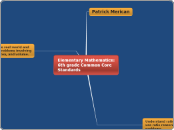Elementary Mathematics: 6th grade Common Core Standards
Patrick Merican
Understand ratio concepts and use ratio reasoning to solve problems.
6.RP.A.1: Understand the concept of a ratio and use ratio language to describe a ratio relationship between two quantitie

Here is an example of the concept of a ratio relationship between two quantities. Let take a look at "IN THE CUP" row. We have a total of 45 beans but there are only 30 marked beans. In the ratio of marked to total column, we see 30/45 which the ratio language used is 30 to 45, meaning we have 30 marked beans to 45 total beans in the cup.
6.RP.A.2: Understand the concept of a unit rate a/b associated with a ratio a:b with b ≠ 0, and use rate language in the context of a ratio relationship.

In the recipe we are making, the recipe has a ratio of 3 cups of flour to 4 cups of sugar. As we see above, we have the flour and sugar. Using A:B ratio we have 3:4 or 3/4. So if we decided to use 1 cup of sugar, we would use 3/4 cup of flour.
6.RP.A.3: Use ratio and rate reasoning to solve real-world and mathematical problems, e.g., by reasoning about tables of equivalent ratios, tape diagrams, double number line diagrams, or equations.
Here is a video of using ratio's in a real world application. Another example is you and your friend decide to buy hockey cards. you have 7 dollars and your friend has 3 dollars to spend. Your ratio is 7:10 and your friends is 3:10. if you get 100 cards with 10 dollars, you get 7 out of every 10 cards or 70 and your friend gets 3 of every 10 cards. This also can be read as 70:100 or 70% and 30:100 or 30% of all the cards.
Here is a fun little activity that allows you to see the differece using larger or smaller ratios using different size bike gears. Click the world on the right side of this box.
Geometry: Solve real-world and mathematical problems involving area, surface area, and volume.
6.G.A.1: Find the area of right triangles, other triangles, special quadrilaterals, and polygons by composing into rectangles or decomposing into triangles and other shapes; apply these techniques in the context of solving real-world and mathematical problems. On the right of this box is a game to show examples of areas. The game cuts the shapes into simpilar shapes. try to find them all!
6.G.A.2: Find the volume of a right rectangular prism with fractional edge lengths by packing it with unit cubes of the appropriate unit fraction edge lengths, and show that the volume is the same as would be found by multiplying the edge lengths of the prism. Apply the formulas V = l w h and V = b h to find volumes of right rectangular prisms with fractional edge lengths in the context of solving real-world and mathematical problems.

Here is an example of how to solve right rectangular prism.
Here is a video example of how to find volume of a right rectangular prism
